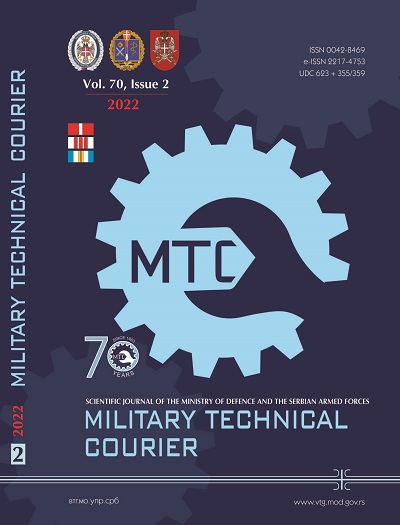Influence of heat input on the tensile properties of austenitic-ferritic welded joints
Abstract
Introduction/purpose: During exploitation tests of gasoline storage tanks, cracks can form in an austenitic-ferrite welded joint, which can compromise the entire tank.
Methods: In order to obtain a welded joint of satisfactory strength and durability, the paper analyzes the influence of heat input on the tensile characteristics of welded joints. In the current literature and practice, additional materials for welding the tank elements are selected according to the chemical compositions of the elements of basic materials, with the help of the Schaeffler diagram. In this paper, the characteristics of welded joints of gasoline storage tanks are examined, when the largest part of the tank is made of fine - grained microalloyed steel NIOMOL 490 K, while the roof part of the tank is made of austenitic steel. Slabs of these two materials were welded by the MIG process with additional material MIG 18/8/6, at different amounts of heat input.
Conclusion: The analysis of the results obtained by tensile testing according to SRPS EN ISO 6892-1: 2020 standard concluded that the behavior of the joint as a whole depends on the properties of each individual part of the welded joint and their mutual influence. It was also concluded that the mutual influence is better if welding is performed with a lower amount of heat input, because then a lower degree of mixing of additional material with basic materials is achieved.
References
Bukvić, A. 2012. Research of the influence of additional materials on the behavior of ferritic austenitic welded joints. Ph.D. thesis. Belgrade: University of Belgrade - Faculty of Mechanical Engineering (in Serbian).
Durmusoglu, Ş., Türker, M. & Tosun, M. 2015. Effect of welding parameters on the mechanical properties of GMA-welded HY-80 steels. Materials Testing, 57(10), pp.866-871. Available at: https://doi.org/10.3139/120.110797
Guo, Y., Collins, D.M., Tarleton, E., Hofmann, F., Tischler, J., Liu, W., Xu, R., Wilkinson, A.J. & Britton, T.B. 2015. Measurements of stress fields near a grain boundary: Exploring blocked arrays of dislocations in 3D. Acta Materialia, 96, pp.229-236. Available at: https://doi.org/10.1016/j.actamat.2015.05.041
-Jesenice Ironworks. 2005. Additional welding materials, catalog. Jesenice Ironworks.
Jovičić, R., Ažman, S., Popović, O. & Prokić–Cvetković, R. 2006. Prednosti primene čelika NIOMOL 490 K pri izradi skladišnih rezervoara za naftne derivate. Energija, 7(3-4), pp.66-69 (in Serbian).
Kassner, M.E. 2015. Fundamentals of Creep in Metals and Alloys, 3rd Edition. Elsevier & Butterworth-Heinemann. ISBN: 9780080994277.
Liu, D. & Pons, D.J. 2017. Physical-mechanism exploration of the low-cycle unified creep-fatigue formulation. Metals, 7(9), art.ID:379. Available at: https://doi.org/10.3390/met7090379
Liu, D. & Pons, D.J. 2018. Crack Propagation Mechanisms for Creep Fatique: A Consolidated Explatation of Fundamental Beaviours from Inititation to Failure. Metals, 8(8), art.ID:623. Available at: https://doi.org/10.3390/met8080623
Miletić, I., Ilić, A., Nikolić, R.R., Ulewicz, R. Ivanović, L . & Sczygiol, N. 2020. Analysis of Selected Properties of Welded Joints of the HSLA Steels. Materials, 13(6), art.ID:1301. Available at: https://doi.org/10.3390/ma13061301
Sankar, N., Malarvizhi, S. & Balasubramanian, V. 2021. Mechanical properties and microstructural characteristics of rotating arc-gas metal arc welded carbon steel joints. Journal of the Mechanical Behavior of Materials, 30(1), pp.49-58. Available at: https://doi.org/10.1515/jmbm-2021-0006
Zhang, X-Z., Zhao, M-S., Chiew, S-P., Lee, C-K. & Fung, T-C. 2015. Influence of welding on the strength of high performance steels. In: 7th Asia Pacific Young Researchers and Graduates Symposium (YRGS 2015), Kuala Lumpur, Malaysia, August 20-21 [online]. Available at: https://hdl.handle.net/10356/80558 [Accessed: 1 Feabruary 2022].
Proposed Creative Commons Copyright Notices
Proposed Policy for Military Technical Courier (Journals That Offer Open Access)
Authors who publish with this journal agree to the following terms:
Authors retain copyright and grant the journal right of first publication with the work simultaneously licensed under a Creative Commons Attribution License that allows others to share the work with an acknowledgement of the work's authorship and initial publication in this journal.
- Authors are able to enter into separate, additional contractual arrangements for the non-exclusive distribution of the journal's published version of the work (e.g., post it to an institutional repository or publish it in a book), with an acknowledgement of its initial publication in this journal.
- Authors are permitted and encouraged to post their work online (e.g., in institutional repositories or on their website) prior to and during the submission process, as it can lead to productive exchanges, as well as earlier and greater citation of published work (See The Effect of Open Access).

